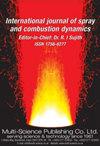用统计模式成像测速法估计汽油直喷喷雾的速度
IF 2.1
4区 工程技术
Q3 ENGINEERING, MECHANICAL
International Journal of Spray and Combustion Dynamics
Pub Date : 2018-06-28
DOI:10.1177/1756827718778289
引用次数: 4
摘要
统计模式成像测速(SPIV)是一种从高速视频中估计平面速度场的新技术。SPIV利用背光或侧光视频的集合来获得喷雾和火焰中的全平面速度。与传统的颗粒成像测速不同,统计模式成像测速不需要湍流中颗粒的高分辨率图像。相反,该技术依赖于流中连贯结构形成的模式。因此,SPIV非常适合于估计喷雾剂和湍流火焰中的平面速度,这两种情况在流动视频中都有明确的模式嵌入。SPIV技术的实现相对来说相当简单,因为高速视频可以在实验室或生产车间环境中轻松获得。SPIV技术面临的最大挑战是,即使使用普通的百万像素相机,该过程的计算成本也很高。为了提高计算速度,采用了逐次划分方案。此外,为了提高亚像素级的空间分辨率,采用了加权中心平均方案。利用这两种增强方法,SPIV方法获得了GDI喷油器喷射时的平面径向和轴向速度。从GDI喷油器喷出的喷雾非常密集(喷油器附近的遮挡度大于99%),速度测量很困难。然而,在远离喷嘴的地方,可以使用相位多普勒风速计来获得速度测量。用这两种方法得到的速度比较吻合。本文章由计算机程序翻译,如有差异,请以英文原文为准。
Estimating velocity in Gasoline Direct Injection sprays using statistical pattern imaging velocimetry
Statistical pattern imaging velocimetry (SPIV) is a new technique for the estimation of the planar velocity field from the high-speed videos. SPIV utilizes an ensemble of either backlit or side lit videos to obtain full planar velocities in sprays and flames. Unlike conventional particle imaging velocimetry, statistical pattern imaging velocimetry does not require well-resolved images of particles within turbulent flows. Instead, the technique relies of patterns formed by coherent structures in the flow. Therefore, SPIV is well suited for the estimating planar velocities in sprays and turbulent flames, both of which have well-defined patterns embedded in the flow videos. The implementation of the SPIV technique is relatively quite straightforward since high-speed videos can be readily obtained either in a laboratory or production floor setting. The biggest challenge for the SPIV techniques is that the procedure is computationally expensive even with an ordinary mega-pixel camera. To improve the computation speed, a successive partitioning scheme was employed. In addition, to improve spatial resolution to subpixel dimensions, a weighted central averaging scheme was used. With these two enhancements, the SPIV method was used to obtain planar radial and axial velocities in a spray emanating from a GDI injector. Sprays from GDI injectors are very dense (with obscuration levels close to the injector being greater than 99%), and velocity measurements are difficult. However, further away from the nozzle, a Phase Doppler Anemometer can be used to obtain velocity measurements. The velocities obtained using these two methods showed reasonable agreement.
求助全文
通过发布文献求助,成功后即可免费获取论文全文。
去求助
来源期刊

International Journal of Spray and Combustion Dynamics
THERMODYNAMICS-ENGINEERING, MECHANICAL
CiteScore
2.20
自引率
12.50%
发文量
21
审稿时长
>12 weeks
期刊介绍:
International Journal of Spray and Combustion Dynamics is a peer-reviewed open access journal on fundamental and applied research in combustion and spray dynamics. Fundamental topics include advances in understanding unsteady combustion, combustion instability and noise, flame-acoustic interaction and its active and passive control, duct acoustics...
 求助内容:
求助内容: 应助结果提醒方式:
应助结果提醒方式:


